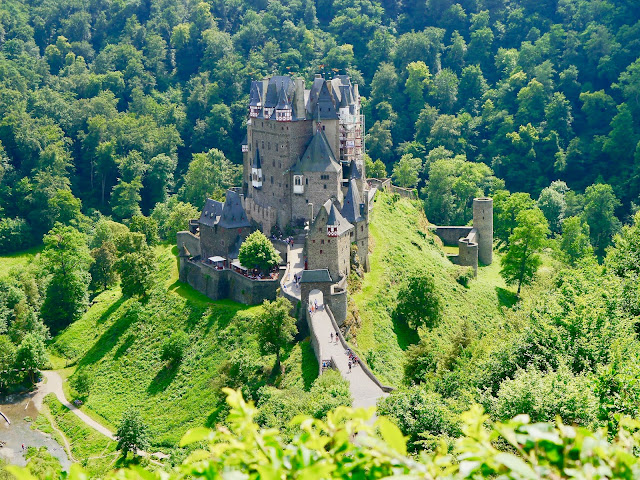Zamek Eltz - jeden z najpiękniejszych zamków w dolinie Mozeli / Eltz Castle - one of the most beautiful castles in the Moselle valley
Zamek Eltz (Burg Eltz) jeden z najpiękniejszych średniowiecznych zamków niemieckich.
Jest
jednym z nielicznych zamków w dolinie rzek Mozeli i Renu, ktore nie
zostały zniszczone ani poważnie uszkodzone w czasie Wojny
Trzydziestoletniej (1618-1648). Wojska francuskie nie zniszczyły tego zamku ze
względu na jego niezwykłą lokalizację, a także dyplomatyczne zachowanie
właścicieli zamku.
Historia zamku Eltz jest bardzo interesująca i
dosyć fascynująca.
Zamek ten jest własnością tej samej rodziny od XII
wieku
i nadal pozostaje prywatną własnościa rodziny Eltz przez ponad 850
lat lub od 33 pokoleń.
Najwcześniejsza wzmianka o zamku Eltz jest datowana na rok 1157.
Został on zbudowany w celach obronnych i dla ochrony szlaku handlowego.
W 1268 roku trzech braci Eltz podzieliło Burg Eltz miedzy soba. Trzy gałęzie rodziny Eltz (Kempenich,
Rodendorf i Rübenach) było wspólnymi właścicielami zamku do 1815 rok. W
tym roku całkowita własność zamku została przejęta przez rodzinę
Kempenich, którzy są właścicielami zamku do dnia dzisiejszego. Cześci zamku bedące własnością rodzin Rodendorf i Rübenach są otwarte dla publiczności, natomiast rodzina Kempenich korzysta z trzeciej części zamku.
Eltz Castle -it
is one of the few castles in the valley of the Moselle and Rhine
rivers which were not destroyed or seriously damaged during the Thirty
Years' War. French troops did not destroy this castle due to its unusual location, as well as the diplomatic behavior of the castle owners.The history of the Eltz castle is very interesting and quite fascinating. The
castle has been owned by the same family since the 12th century and
remains the private property of the Eltz family for over 850 years or
for 33 generations.
The
earliest mention of the Eltz castle is dated back to 1157.
It was built
for defensive purposes and for the protection of the trade route.In 1268, three Eltz brothers shared the Burg Eltz among themselves. The three branches of the Eltz family (Kempenich, Rodendorf and Rübenach) were the joint owners of the castle until 1815. This year, the castle's total ownership was taken over by the Kempenich family, who own the castle to this day. The castle parts of Rodendorf and Rübenach are open to the public, while the Kempenich family uses the third part of the castle.
Budowa zamku Eltz została zakończona w latach 1490 -1540.
W XV wieku zamek wygladał tak jak dzisiaj - jedna duża fortyfikacja z trzema
pięknymi rezydencjami wielkich niemieckich rodzin wokół małego dziedzińca.
Rodzina Eltz przez wiele wieków dbała o zamek, kontynowała renowacje i konserwcje zamku. 80-pokojowy zamek jest nadal zamieszkały i wygląda tak jak setki lat temu.
The construction of the Eltz castle was completed in the years 1490 -1540.
In the fifteenth century, the castle looked like today - one large fortification with three beautiful residences of great German families around a small courtyard. For many centuries the Eltz family cared for the castle, continued renovating and preserving the castle.The 80-room castle is still inhabited and looks just like hundreds of years ago.
In the fifteenth century, the castle looked like today - one large fortification with three beautiful residences of great German families around a small courtyard. For many centuries the Eltz family cared for the castle, continued renovating and preserving the castle.The 80-room castle is still inhabited and looks just like hundreds of years ago.
Wewnętrzny
dziedziniec zamku Eltz, gdzie można widzieć wyniki ponad 500-letniego budowania
tego zamku przez trzy gałęzie rodziny Eltz.
The inner
courtyard of the Eltz castle, where you can see the results of over 500
years of building this castle by three branches of the Eltz family.
Wykusz zamku mieści mała piękną kaplicę. Obok kapliczki widać na murze duże litery JL - nigdzie nie znalazłam wyjaśnienia co one reprezentują.
In the bay window of the castle there is a beautiful little chapel. Next to this chapel you can see the capital letters JL on the wall - nowhere did I find an explanation of what they represent.


















